
Eryops meaning "drawn-out face" because most of its skull was in front of its eyes is a genus of extinct, amphibious temnospondyls. It contains the single species Eryops megacephalus, the fossils of which are found mainly in early Permian rocks of the Texas Red Beds, located in Archer County, Texas. Fossils have also been found in late Carboniferous period rocks from New Mexico. Several complete skeletons of Eryops have been found in lower Permian rocks, but skull bones and teeth are its most common fossils.
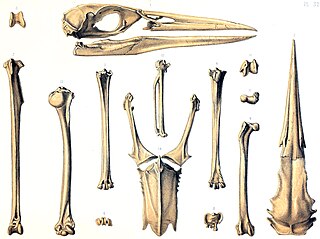
The Rodrigues night heron is an extinct species of heron formerly occurring on the Mascarene island of Rodrigues.
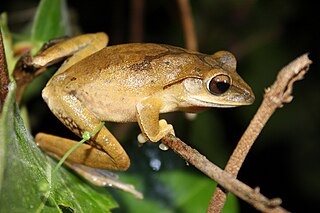
Polypedates megacephalus, the Hong Kong whipping frog or spot-legged tree frog, is a species in the shrub frog family (Rhacophoridae). In its native range, it is also called "brown tree frog", but this name is otherwise applied to a species of the true tree frog family (Hylidae).
Hylaeamys megacephalus, also known as Azara's broad-headed oryzomys or the large-headed rice rat, is a species of rodent in the genus Hylaeamys of family Cricetidae, of which it is the type species. It is found mainly in lowland tropical rainforest from its type locality in Paraguay north through central Brazil, French Guiana, Guyana, Suriname, and Venezuela onto Trinidad and Tobago. To its west and east, other closely related species of Hylaeamys are found: H. perenensis in western Amazonia, H. acritus in Bolivia, and H. laticeps and H. oniscus in the Atlantic Forest of eastern Brazil.
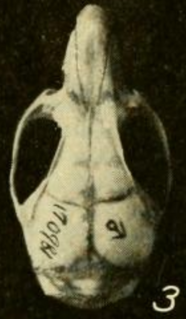
Transandinomys talamancae is a rodent in the genus Transandinomys that occurs from Costa Rica to southwestern Ecuador and northern Venezuela. Its habitat consists of lowland forests up to 1,500 m (5,000 ft) above sea level. With a body mass of 38 to 74 g, it is a medium-sized rice rat. The fur is soft and is reddish to brownish on the upperparts and white to buff on the underparts. The tail is dark brown above and lighter below and the ears and feet are long. The vibrissae (whiskers) are very long. In the skull, the rostrum is long and the braincase is low. The number of chromosomes varies from 34 to 54.
Pithecopus megacephalus, also known as the large-headed leaf frog, is a species of frog in the family Phyllomedusidae. It is endemic to Brazil and is only known from a few peaks in the Espinhaço Mountains in the state of Minas Gerais.
The dark kangaroo mouse is a species of rodent in the family Heteromyidae. It is found in California, Idaho, Nevada, Oregon and Utah in the United States.
Eurycleidus is an extinct genus of large-bodied rhomaleosaurid known from the Early Jurassic period of the United Kingdom. It contains a single species, E. arcuatus. Like other plesiosaurs, Eurycleidus probably lived on a diet of fish, using its sharp needle-like teeth to catch prey. Its shoulder bones were fairly large, indicating a powerful forward stroke for fast swimming.
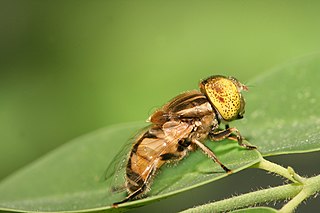
Eristalinus megacephalus is a species of hoverfly.

Atychodracon is an extinct genus of rhomaleosaurid plesiosaurian known from the Late Triassic - Early Jurassic boundary of England. It contains a single species, Atychodracon megacephalus, named in 1846 originally as a species of Plesiosaurus. The holotype of "P." megacephalus was destroyed during a World War II air raid in 1940 and was later replaced with a neotype. The species had a very unstable taxonomic history, being referred to four different genera by various authors until a new genus name was created for it in 2015. Apart from the destroyed holotype and its three partial casts, a neotype and two additional individuals are currently referred to Atychodracon megacephalus, making it a relatively well represented rhomaleosaurid.

Crossocerus is a genus of square-headed wasps in the family Crabronidae. There are at least 250 described species in Crossocerus.

Corusichthys megacephalus is an extinct pycnodontid that lived during the lower Cenomanian of what is now Lebanon. C. megacephalus is known from a 34 mm long fossil. It had plates arranged like a helmet around its head, and had a massive, triangular spine on its dorsal side. C. megacephalus is closely related the genera Trewavasia and Hensodon, as well as Coccodus.
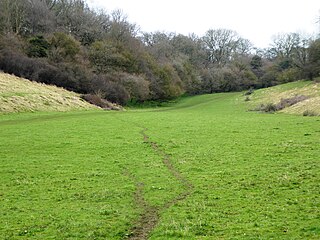
Great Shuttlesfield Down is a 21.8-hectare (54-acre) biological Site of Special Scientific Interest north of Folkestone in Kent.
Crossocerus impressifrons is a species of square-headed wasp in the family Crabronidae. It is found in North America.

Crossocerus nitidiventris is a species of square-headed wasp in the family Crabronidae. It is found in North America.

Crossocerus elongatulus is a Palearctic species of solitary wasp.
Crossocerus styrius is a Palearctic species of solitary wasp.
Crossocerus walkeri is a Palearctic species of solitary wasp.











